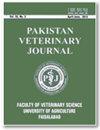求助PDF
{"title":"反复暴露于青蒿素对感染伯氏疟原虫小鼠肺、肾和脑的吸附及组织病理学改变","authors":"L. Maslachah","doi":"10.29261/pakvetj/2019.018","DOIUrl":null,"url":null,"abstract":"Received: Revised: Accepted: Published online: February 03, 2018 June 12, 2018 September 30, 2018 January 28, 2019 The purpose of this study was to determine the pathogenesis of malarial infection in rodent as in vivo model in humans due to repeated exposure of artemisinin through organ histopathological picture. Healthy adult Albino swiss mice with average weight of 20-30 g were used for the study. Fifteen mice were divided into three groups: mice were infected with Plasmodium berghei which has been ever treated with artemisinin up to 4 times than treated by artemisinin (T4), infected mice with Plasmodium berghei which untreated by artemisinin as a control (C), infected mice with Plasmodium berghei which has been ever treated by artemisinin 4 times but untreated as a treatment control (TC). T4 group was oral administered with artemisinin which was given with \"4-day-test\" (4-DT) with ED99 dose (200 mg/kg weight of mice) for 3 days which begins 48 hours after infection but C and TC group were given aquadest. The histopathology of the lung, kidney and brain (cerebrum) was studied by routine histology method with Haematoxylin-Eosin staining. Histopathological parameters including edema, hemosiderin, thickened alveolar septa and inflammatory cell infiltration occurred in the lung. Cast formation, glomerulonephritis, tubular necrosis, and congestion could be seen in the cortex area of the kidney. The brain showed cerebral microvessels congested, hemorrhages and necrosis. In conclusion, repeated artemisinin exposure with repeated passages in mice cause increasing of sequestration on the lung and brain and increasing the histopathological changes of the lung, kidney and brain. ©2018 PVJ. All rights reserved","PeriodicalId":19845,"journal":{"name":"Pakistan Veterinary Journal","volume":" ","pages":""},"PeriodicalIF":3.8000,"publicationDate":"2019-10-01","publicationTypes":"Journal Article","fieldsOfStudy":null,"isOpenAccess":false,"openAccessPdf":"","citationCount":"3","resultStr":"{\"title\":\"Sequestration and Histopathological Changes of the Lung, Kidney and Brain of Mice Infected with Plasmodium berghei that Exposed to Repeated Artemisinin\",\"authors\":\"L. Maslachah\",\"doi\":\"10.29261/pakvetj/2019.018\",\"DOIUrl\":null,\"url\":null,\"abstract\":\"Received: Revised: Accepted: Published online: February 03, 2018 June 12, 2018 September 30, 2018 January 28, 2019 The purpose of this study was to determine the pathogenesis of malarial infection in rodent as in vivo model in humans due to repeated exposure of artemisinin through organ histopathological picture. Healthy adult Albino swiss mice with average weight of 20-30 g were used for the study. Fifteen mice were divided into three groups: mice were infected with Plasmodium berghei which has been ever treated with artemisinin up to 4 times than treated by artemisinin (T4), infected mice with Plasmodium berghei which untreated by artemisinin as a control (C), infected mice with Plasmodium berghei which has been ever treated by artemisinin 4 times but untreated as a treatment control (TC). T4 group was oral administered with artemisinin which was given with \\\"4-day-test\\\" (4-DT) with ED99 dose (200 mg/kg weight of mice) for 3 days which begins 48 hours after infection but C and TC group were given aquadest. The histopathology of the lung, kidney and brain (cerebrum) was studied by routine histology method with Haematoxylin-Eosin staining. Histopathological parameters including edema, hemosiderin, thickened alveolar septa and inflammatory cell infiltration occurred in the lung. Cast formation, glomerulonephritis, tubular necrosis, and congestion could be seen in the cortex area of the kidney. The brain showed cerebral microvessels congested, hemorrhages and necrosis. In conclusion, repeated artemisinin exposure with repeated passages in mice cause increasing of sequestration on the lung and brain and increasing the histopathological changes of the lung, kidney and brain. ©2018 PVJ. All rights reserved\",\"PeriodicalId\":19845,\"journal\":{\"name\":\"Pakistan Veterinary Journal\",\"volume\":\" \",\"pages\":\"\"},\"PeriodicalIF\":3.8000,\"publicationDate\":\"2019-10-01\",\"publicationTypes\":\"Journal Article\",\"fieldsOfStudy\":null,\"isOpenAccess\":false,\"openAccessPdf\":\"\",\"citationCount\":\"3\",\"resultStr\":null,\"platform\":\"Semanticscholar\",\"paperid\":null,\"PeriodicalName\":\"Pakistan Veterinary Journal\",\"FirstCategoryId\":\"97\",\"ListUrlMain\":\"https://doi.org/10.29261/pakvetj/2019.018\",\"RegionNum\":3,\"RegionCategory\":\"农林科学\",\"ArticlePicture\":[],\"TitleCN\":null,\"AbstractTextCN\":null,\"PMCID\":null,\"EPubDate\":\"\",\"PubModel\":\"\",\"JCR\":\"Q1\",\"JCRName\":\"VETERINARY SCIENCES\",\"Score\":null,\"Total\":0}","platform":"Semanticscholar","paperid":null,"PeriodicalName":"Pakistan Veterinary Journal","FirstCategoryId":"97","ListUrlMain":"https://doi.org/10.29261/pakvetj/2019.018","RegionNum":3,"RegionCategory":"农林科学","ArticlePicture":[],"TitleCN":null,"AbstractTextCN":null,"PMCID":null,"EPubDate":"","PubModel":"","JCR":"Q1","JCRName":"VETERINARY SCIENCES","Score":null,"Total":0}
引用次数: 3
引用
批量引用
Sequestration and Histopathological Changes of the Lung, Kidney and Brain of Mice Infected with Plasmodium berghei that Exposed to Repeated Artemisinin
Received: Revised: Accepted: Published online: February 03, 2018 June 12, 2018 September 30, 2018 January 28, 2019 The purpose of this study was to determine the pathogenesis of malarial infection in rodent as in vivo model in humans due to repeated exposure of artemisinin through organ histopathological picture. Healthy adult Albino swiss mice with average weight of 20-30 g were used for the study. Fifteen mice were divided into three groups: mice were infected with Plasmodium berghei which has been ever treated with artemisinin up to 4 times than treated by artemisinin (T4), infected mice with Plasmodium berghei which untreated by artemisinin as a control (C), infected mice with Plasmodium berghei which has been ever treated by artemisinin 4 times but untreated as a treatment control (TC). T4 group was oral administered with artemisinin which was given with "4-day-test" (4-DT) with ED99 dose (200 mg/kg weight of mice) for 3 days which begins 48 hours after infection but C and TC group were given aquadest. The histopathology of the lung, kidney and brain (cerebrum) was studied by routine histology method with Haematoxylin-Eosin staining. Histopathological parameters including edema, hemosiderin, thickened alveolar septa and inflammatory cell infiltration occurred in the lung. Cast formation, glomerulonephritis, tubular necrosis, and congestion could be seen in the cortex area of the kidney. The brain showed cerebral microvessels congested, hemorrhages and necrosis. In conclusion, repeated artemisinin exposure with repeated passages in mice cause increasing of sequestration on the lung and brain and increasing the histopathological changes of the lung, kidney and brain. ©2018 PVJ. All rights reserved


